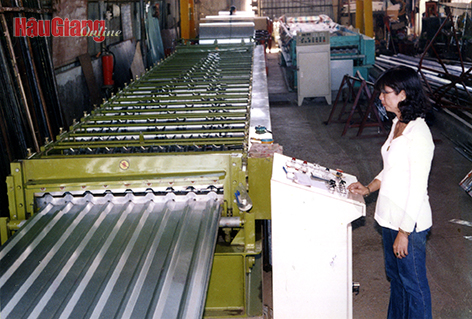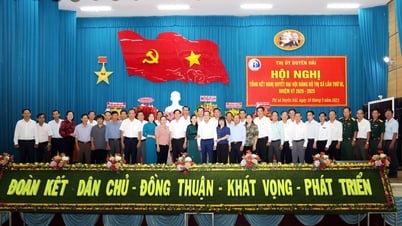Entering the period of renovation, from the state's policy of recognizing multi-sector economy . Applying the contract mechanism, 56 new small-scale industrial establishments were established, most of them in Vi Thanh town, attracting thousands of workers to participate.
Corrugated iron sheets in Vi Thanh town (around 2007-2008).
Implementing the mechanism of eliminating subsidies, state-owned enterprises balance their own revenues and expenditures and consume products. At the same time, the state encourages the development of economic sectors. Due to not being able to innovate in time to follow the new situation, some state-owned enterprises suffered losses and had to stop operating or dissolve due to debts such as: Food processing enterprises, soap oil pressing enterprises, wood enterprises and some state-owned milling factories. Besides, there are still some stable production units that adapt to the new mechanism such as: Tractor enterprises, sugar enterprises, ice enterprises, etc. Most of them are located in Vi Thanh town.
In the period 1988-1998, Vi Thanh district arranged industrial and handicraft activities into 4 main sectors: Food processing, mechanical repair, construction materials production, consumer goods production. In 1995, Can Tho province invested in building a sugar factory with a capacity of 1,000 tons/day and a rice processing factory in Hoa Luu commune, with modern Danish technology, with a capacity of 10 tons/hour. These were the 2 largest industrial establishments in Vi Thanh - Hoa Luu area at the time of establishment.
At the end of 1999, Vi Thanh town was re-established; this was an opportunity and favorable condition for Vi Thanh to develop its economy comprehensively, in the period of industrialization and modernization. This was also the time when the town redefined its economic structure of "industry - handicrafts, agriculture and trade - services". Vi Thanh town was identified by the province as the third industrial park planning, after Tra Noc and Hung Phu industrial parks. Accordingly, the project has a total area of 150 hectares, is a mixed industrial park with many industries, closely related to 3 provinces: Can Tho - Kien Giang - Bac Lieu.
At the same time, the Vi Thanh town industrial cluster, with an area of 62.5 hectares, was approved by the People's Committee of Can Tho province on August 2, 2002. Initially, the town mobilized 9 production establishments to register for the industrial - handicraft cluster with an area of 24 hectares, attracting hundreds of workers.
As of April 30, 2001, the entire Vi Thanh town had 198 production facilities and 2,005 workers. Of these, there were 2 state-owned factories and about 700 workers at Vi Thanh Sugar Factory, with a capacity of 1,300 tons of sugarcane per day. The town's industrial production output value reached 81.7 billion VND.
However, it can be seen that the actual development speed of industry and handicrafts in Vi Thanh town is still slow, most of them are small production facilities, with an average of 4-5 workers/facility... On the other hand, due to old and outdated equipment, low investment capital, and a small technical workforce, the products produced are not many and lack competitiveness. The processing of pineapple specialties, the town's strength, has not yet produced competitive products in the market.
To keep up with the general economic development; Hau Giang province has a policy to establish Song Hau industrial zones (Chau Thanh district), Tan Phu Thanh (Chau Thanh A district), to take advantage of the proximity to Can Tho city. At this time, industrial and handicraft zones and clusters in the town have not yet developed. From there, Vi Thanh promptly re-determined a new direction; focusing on the primary goal of developing trade and services. Under the direction of Hau Giang province, Vi Thanh city has eliminated the planning for industrial park construction, focusing only on promoting industrial and handicraft clusters, with key production strengths: rice processing, sugar processing, wood processing, mechanics, construction materials, plastic products, garments, etc.
Encouraged, supported and encouraged by the city, handicrafts have gradually recovered and developed, such as: food processing facilities, leaf weaving, water hyacinth weaving, handicrafts, etc. However, with the advent of new construction technology, blacksmithing, carpentry and boat building are no longer as prosperous as before; the number of workers has also gradually decreased.
By the end of 2020, industrial and handicraft activities in Vi Thanh city continued to achieve positive results, most establishments, companies and enterprises had stable production, and goods were competitive in the market. In the industrial - handicraft cluster, there were 26 investors registered in the form of land lease and land allocation; total investment of 1,201 billion VND, total area of 42.95/43.44ha; accounting for 98.87%.
Many production facilities have new inventions, such as making iron chopsticks (instead of wood), rice threshing machines, improved tillers, pressure sprayers, etc. In the area, there are 10 wood sawmills and 4-5 mobile forges using chopsticks, operating on the river regularly serving people in the suburbs and neighboring districts.
It can be said that from the time of land reclamation, at the end of the Nguyen Dynasty - the first rudimentary handicrafts began to take shape, with carpentry: building huts, building houses; weaving leaves to roof houses... Gradually, carpentry became more sophisticated, and boats, canoes, and houses with canoes were built. At the same time, blacksmiths were born, meeting the needs of household tools and farming tools, fishing tools, beekeeping tools,...
When the French carried out large-scale exploitation, digging canals, building roads, setting up markets, etc., small-scale handicraft activities made many further advances with tin-welding, goldsmithing; semi-industrial rice mills. During the French colonial period, with the advancement of the mechanical industry, water and land transport developed; ships and vehicles became modern means of transportation. In particular, with the appearance of large rice mills of the landlords, the industry - small-scale handicraft of Vi Thanh - Hoa Luu took shape, continued to develop during the two resistance wars, especially when Vi Thanh became a quite bustling provincial capital - military city during the resistance war against the US. Before April 30, 1975, the Vi Thanh - Hoa Luu area had about 50% of its agricultural production area mechanized, with the use of plows, water pumps, rice threshers, etc. In the town area, many production facilities were re-operated or newly opened, with the climax being the establishment of the Vi Thanh Sugar Factory and the Danish Rice Processing Factory, along with industrial clusters - small-scale industries; industrial clusters - warehouses and wharves, etc. After some difficulties, by 2020, it continued to attract many investors to carry out production projects.
The results of the process of formation and development of industry and handicrafts in Vi Thanh - Hoa Luu area show a close connection with agricultural production; rice, sugarcane, and pineapple have become the main sources of raw materials.
CLEAN TASTE
Source




![[Photo] Journalists moved to tears at the Memorial Service for the soldiers who died in Gac Ma](https://vphoto.vietnam.vn/thumb/1200x675/vietnam/resource/IMAGE/2025/5/30/9454613a55c54c16bf8c0efa51883456)
![[Photo] National Conference "100 years of Vietnamese Revolutionary Press accompanying the glorious cause of the Party and the nation"](https://vphoto.vietnam.vn/thumb/1200x675/vietnam/resource/IMAGE/2025/5/30/1cf6cd5c8a934ebfa347028dcb08358c)
![[Photo] A delegation of 100 journalists from the Vietnam Journalists Association visits the soldiers and people of Truong Sa island district.](https://vphoto.vietnam.vn/thumb/1200x675/vietnam/resource/IMAGE/2025/5/30/0984a986227d4e988177f560d2e1563e)

![[Photo] General Secretary To Lam receives Chief of the Central Office of the Lao People's Revolutionary Party](https://vphoto.vietnam.vn/thumb/1200x675/vietnam/resource/IMAGE/2025/5/30/140435f4b39d4599a3d17975dfb444c5)
















































































Comment (0)